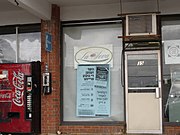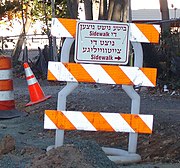Loading AI tools
Yiddish has been present in the United States since at least the late 19th century and continues to have roughly 148,000 speakers as of the 2009 American Community Survey.

Today, more than half of the Yiddish speakers in the United States are concentrated in the New York state, with smaller but significant populations in Florida, New Jersey and California.
In the United States, at first most Jews were of Sephardic origin, and hence did not speak Yiddish. It was not until the mid-to-late 19th century, as first German Jews, then Central and Eastern European Jews, arrived in the nation, that Yiddish became dominant within the immigrant community. This helped to bond Jews from many countries. פֿאָרווערטס (Forverts – The Forward) was one of seven Yiddish daily newspapers in New York City, and other Yiddish newspapers served as a forum for Jews of all European backgrounds. In 1915, the circulation of the daily Yiddish newspapers was half a million in New York City alone, and 600,000 nationally. In addition, thousands more subscribed to the numerous weekly papers and the many magazines.[3]
The typical circulation in the 21st century is a few thousand. The Forward still appears weekly and is also available in an online edition.[4] It remains in wide distribution, together with דער אַלגעמיינער זשורנאַל (der algemeyner zhurnal – Algemeyner Journal; algemeyner = general), a Chabad newspaper which is also published weekly and appears online.[5] The widest-circulation Yiddish newspapers are probably the weekly issues Der Yid (דער איד "The Jew"), Der Blatt (דער בלאַט; blat "paper") and Di Tzeitung (די צייטונג "the newspaper"). Several additional newspapers and magazines are in regular production, such as the weekly אידישער טריביון Yiddish Tribune and the monthly publications דער שטערן (Der Shtern "The Star") and דער בליק (Der Blik "The View"). (The romanized titles cited in this paragraph are in the form given on the masthead of each publication and may be at some variance both with the literal Yiddish title and the transliteration rules otherwise applied in this article.) Thriving Yiddish theater, especially in the New York City Yiddish Theatre District, kept the language vital. Interest in klezmer music provided another bonding mechanism.
Most of the Jewish immigrants to the New York metropolitan area during the years of Ellis Island considered Yiddish their native language; however, native Yiddish speakers tended not to pass the language on to their children, who assimilated and spoke English. For example, Isaac Asimov states in his autobiography In Memory Yet Green that Yiddish was his first and sole spoken language, and remained so for about two years after he emigrated to the United States as a small child. By contrast, Asimov's younger siblings, born in the United States, never developed any degree of fluency in Yiddish.
In 1976, the Canadian-born American author Saul Bellow received the Nobel Prize in Literature. He was fluent in Yiddish, and translated several Yiddish poems and stories into English, including Isaac Bashevis Singer's "Gimpel the Fool". In 1978, Singer, a writer in the Yiddish language, who was born in Poland and lived in the United States, received the Nobel Prize in Literature.
Distribution

More than 100,000 speakers
More than 10,000 speakers
More than 5,000 speakers
More than 1,000 speakers
Fewer than 1,000 speakers
In the 2000 United States Census, 178,945 people in the United States reported speaking Yiddish at home. Of these speakers, 113,515 lived in New York (63.43% of American Yiddish speakers); 18,220 in Florida (10.18%); 9,145 in New Jersey (5.11%); and 8,950 in California (5.00%). The remaining states with speaker populations larger than 1,000 are Pennsylvania (5,445), Ohio (1,925), Michigan (1,945), Massachusetts (2,380), Maryland (2,125), Illinois (3,510), Connecticut (1,710), and Arizona (1,055). The population is largely elderly: 72,885 of the speakers were older than 65, 66,815 were between 18 and 64, and only 39,245 were age 17 or lower.[6]
In the six years since the 2000 census, the 2006 American Community Survey reflected an estimated 15 percent decline of people speaking Yiddish at home in the U.S. to 152,515.[7] In 2011, the number of persons in the United States above the age of five speaking Yiddish at home was 160,968.[8] 88% of them were living in four metropolitan areas – New York City and another metropolitan area just north of it, Miami, and Los Angeles.[9]
There are a few predominantly Hasidic communities in the United States in which Yiddish remains the majority language including concentrations in the Crown Heights, Borough Park, and Williamsburg neighborhoods of Brooklyn. In Kiryas Joel in Orange County, New York, in the 2000 census, nearly 90% of residents of Kiryas Joel reported speaking Yiddish at home.[10]
New York state
New Square, New York Kiryas Joel, New York Kaser, New York
- Jewish weaving shop on Broom Street, New York City, 1942.
- Sign leaving Brooklyn on Williamsburg Bridge saying "Leaving Brooklyn: Oy Vey!"
- A 2008 election poster in front of a store in New Square, entirely in Yiddish. The candidate names are written in Yiddish.
- Entry of the Satmar Yeshiva in Broolyn, New York.
- A road sign in Yiddish at a construction site in Monsey, NY.).
- A typical poster-hung wall in Jewish Brooklyn, New York
The number of Yiddish speakers in the United States has diminished with the years. Despite this growing popularity among many American Jews,[11] finding opportunities for practical use of Yiddish is becoming increasingly difficult, and thus many students have trouble learning to speak the language.[12] One solution has been the establishment of a farm in Goshen, New York, for Yiddishists.[13]
Newspapers
Category:Yiddish-language newspapers published in the United States Der Yid
Poetry
Category:American poets in Yiddish
Theatre
Category:Yiddish theatre in the United States
Film
A Gesheft I Want to Be a Boarder A Life Apart: Hasidism in America
The American film from 1932 Joseph in the Land of Egypt (Yiddish title: Yoysef in Mitsraim) is considered to be the first talkie filmed in Yiddish.[14] The film is based on the biblical drama "Joseph and His Brethren".
In 1975, the film Hester Street, much of which is in Yiddish, was released. It was later chosen to be on the Library of Congress National Film Registry for being considered a "culturally, historically, or aesthetically significant" film.[15]
Other
Kol Mevaser
Connie Francis Sings Jewish Favorites
Many "Yiddishisms", like "Italianisms" and "Spanishisms", entered New York City English, often used by Jews and non-Jews alike, unaware of the linguistic origin of the phrases. Yiddish words used in English were documented extensively by Leo Rosten in The Joys of Yiddish.
Legal scholars Eugene Volokh and Alex Kozinski argue that Yiddish is "supplanting Latin as the spice in American legal argot".[16][17]
Wikiwand in your browser!
Seamless Wikipedia browsing. On steroids.
Every time you click a link to Wikipedia, Wiktionary or Wikiquote in your browser's search results, it will show the modern Wikiwand interface.
Wikiwand extension is a five stars, simple, with minimum permission required to keep your browsing private, safe and transparent.





